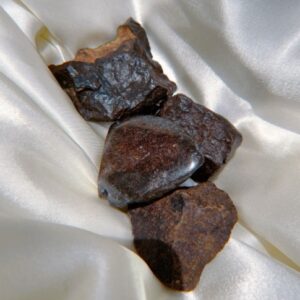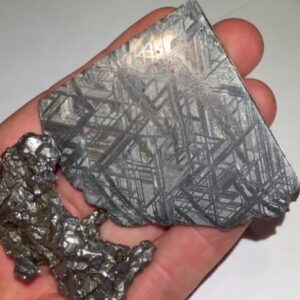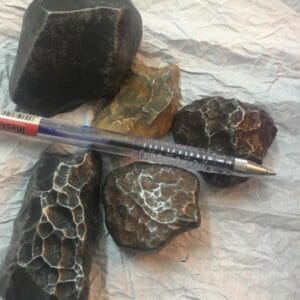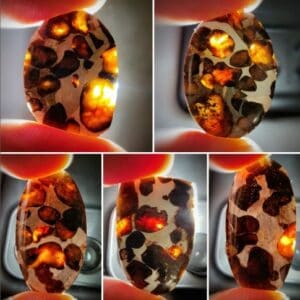The rarest types of rocks on Earth are Meteorites because they don’t come from Earth. Instead, they were formed in space and crash-landed on Earth. As you can imagine, thousands of rock specimens are sent to laboratories annually by individuals who think they’ve found a Meteorite.
I receive a fair share of emails asking me to help identify rocks and 20% of the time people believe they have a space rock or Meteorite. Most of the time these rocks are ordinary rocks with some type of iron coating on them.
There are times when I come across an authentic Meteorite collected by an individual and family member and when this happens the owner wants to know “How much is my meteorite worth“?
Let’s dig into some basic characteristics of how to identify a Meteorite. These simple, at-home methods will save you time and money.

Meteorite Types
There are three basic types of Meteorites but there are subgroups of each category that extend the families of space rocks.
- Iron Meteorites
- Stony Meteorites
- Chondrites
- Achondrites
- Planetary Achondrites
- Stony-Iron Meteorites
- Pallasites
- Mesosiderites
Iron Meteorites
The Iron group of Meteorites is primarily composed of nickel-iron metal. Many of the craters formed by Iron Meteorites are caused by the fact that the metals are so strong the asteroids survive without breaking up on their way to the ground.
One thing you want to remember is magnets are strongly attracted to Iron Meteorites.
Stony Meteorites
These specimens are almost entirely composed of rocky material and are the variety most commonly found. There are dozens of subgroups in this family, but the list above is the simplest breakdown of them all. Meteorites containing the Achondrite family are said to have unique origins.
Stony Iron Meteorites
These meteorites are a mixture of nearly 50% Nickel-Iron metal and 50% rock. Pallasites contain Olivine Crystals as the rock, while Mesosiderites contain various Silicate minerals.

Fusion Crust
All Meteorites soar through the atmosphere at such high velocities that the exterior materials are burned off. The burning effect leaves a glassy outer coating called a fusion crust.
Fusion crusts are usually dark gray to charcoal black in color with a shiny or dull, velvety texture. Some specimens have lines and flow marks from the movement of molten space rocks across the surface.
It’s common to find fusion crust with chips in it, and weathering can leave very little of the crust behind over time.
Meteorite Shapes
Contrary to popular belief, Meteorites are not round. Most specimens have irregular shapes with angular and rounded corners. Some samples display pits on their surfaces, called thumbprints, or, scientifically speaking, regmaglypts. These thumbprints are formed as hot air currents erode the rock while plunging through the atmosphere.
Color
Fresh Meteorites are often black because the fusion crust hasn’t been weathered away. When observing the stone you might notice flow lines and thumbprints which are useful for identification. However, these space stones can change color after a long while on the ground. The fusion crust begins to wear away, and the many details disappear.
Similar to Iron tools, the Iron within Meteorites will become rusty-colored. It starts as spots of red or orange on the black fusion crust, and as time goes by, the entire stone becomes a rusty brown hue but if you look closely you’ll see fusion crust. However, it will no longer be a dark black color, as that begins to fade as well.

Magnet Test
A vast majority of Meteorites naturally contain metallic Iron, while others are almost entirely solid Iron. This makes most of the space rocks responsive to magnets.
Most of the time Meteorites will hold a strong magnet placed on them. This is true, even when the rocks are a low iron type.
The magnet test is the first simple test to use at home or in the field, but only use the test on suspected common Meteorites. It’s wise to avoid exposing Meteorites of scientific interest to magnets.
Rare Earth magnets are inexpensive and the best variety for testing meteorites.
There are various rocks and stones on Earth that respond to magnets, which can make things more challenging because they are relatively common. Hematite and Magnetite are two of the most often misidentified specimens. Especially because they sometimes look like small Meteorites.
This is why you want to continue testing the stone to ensure you have an authentic Meteorite.

Streak Test
Using the streak test is an incredibly common practice in geology and gemology. A mineral or rock is rubbed across a porcelain streak plate to unveil the color of the mineral powder that presents itself.
It is handy for examining suspected space rocks too. Meteorites produce a brown streak during a streak test. However, as we mentioned previously, Hematite and Magnetite are the two most commonly misidentified rocks.
When using the streak test on a Meteorite, if the streak isn’t brown, it’s not a Meteorite. A dark red streak will result from testing Hematite, and Magnetite produces a black streak.
So, suppose you tested the stone specimen, and it’s responsive to a magnet. In that case, it’s time to test the mineral’s streak to help you further identify your bounty.
Before you rush out to purchase a streak plate, you can use an alternative for this test. The non-galvanized backside of a ceramic tile works equally as well for this test, and it’s less expensive.
- Identify Enstatite - March 12, 2024
- Identify Cerussite - March 3, 2024
- Identify Bytownite - February 18, 2024
